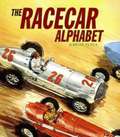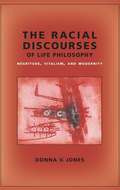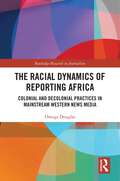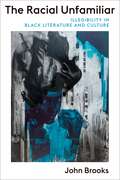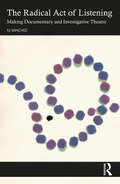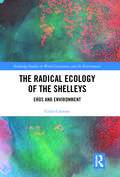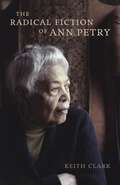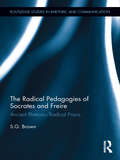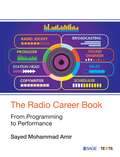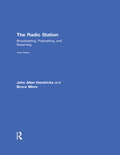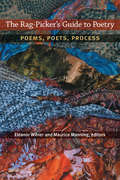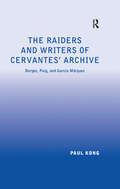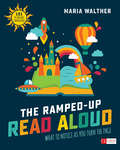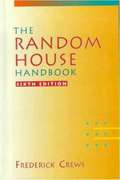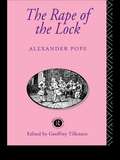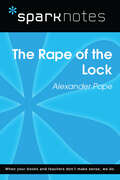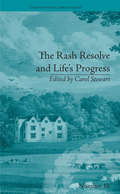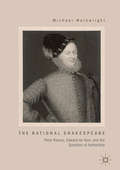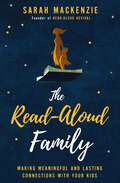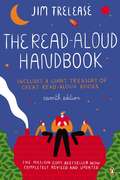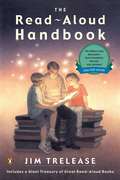- Table View
- List View
The Racecar Alphabet
by Brian FlocaA is for Automobiles, machines on wheels. B is for Belts turning, fuel burning, the buzz and bark of engines. C is for Curves and crowds and cars, of course --A century of racecars, from bare beginnings to present-day marvels, from stock cars to Formula 1, from Ford to Ferrari, caught in crackling action, in fan-friendly pictures, and in words that bounce and jounce for the fun of it.
The Racial Discourses of Life Philosophy: Négritude, Vitalism, and Modernity (New Directions in Critical Theory #45)
by Donna JonesIn the early twentieth century, the life philosophy of Henri Bergson summoned the élan vital, or vital force, as the source of creative evolution. Bergson also appealed to intuition, which focused on experience rather than discursive thought and scientific cognition. Particularly influential for the literary and political Négritude movement of the 1930s, which opposed French colonialism, Bergson's life philosophy formed an appealing alternative to Western modernity, decried as "mechanical," and set the stage for later developments in postcolonial theory and vitalist discourse. Revisiting narratives on life that were produced in this age of machinery and war, Donna V. Jones shows how Bergson, Nietzsche, and the poets Leopold Senghor and Aimé Césaire fashioned the concept of life into a central aesthetic and metaphysical category while also implicating it in discourses on race and nation. Jones argues that twentieth-century vitalism cannot be understood separately from these racial and anti-Semitic discussions. She also shows that some dominant models of emancipation within black thought become intelligible only when in dialogue with the vitalist tradition. Jones's study strikes at the core of contemporary critical theory, which integrates these older discourses into larger critical frameworks, and she traces the ways in which vitalism continues to draw from and contribute to its making.
The Racial Dynamics of Reporting Africa: Colonial and Decolonial Practices in Mainstream Western News Media (Routledge Research in Journalism)
by Omega DouglasThis book critically considers how and why centring race in the analysis of journalism deepens our understanding of how race is constructed and experienced in society. In doing so, it offers a theoretical framework for unpacking and dismantling racism within journalism practice and representation.Linking race critical, post- and decolonial theories to the structural-constructivist framework of journalistic field theory, this book examines the role of Black journalists and INGOs in reporting on sub-Saharan Africa in dominant British news organisations. This study goes beyond journalistic representation to consider the racial dynamics informing the production of Western news and the complex relations between journalists of colour and the institutional culture of dominant Western news organisations. Through a case study and in-depth original interviews, the author addresses the racialisation of mainstream UK news production and news representations of Africa and shows how and why mediated racialised discourses occur and recur, as well as what to do about them.Advancing studies of race, representation, Black identities and journalism studies, The Racial Dynamics of Reporting Africa contributes to decolonising journalism, media and communication studies. It is recommended reading for students, academics and practitioners in these areas.
The Racial Unfamiliar: Illegibility in Black Literature and Culture (Literature Now)
by John BrooksThe works of African American authors and artists are too often interpreted through the lens of authenticity. They are scrutinized for “positive” or “negative” representations of Black people and Black culture or are assumed to communicate some truth about Black identity or the “Black experience.” However, many contemporary Black artists are creating works that cannot be slotted into such categories. Their art resists interpretation in terms of conventional racial discourse; instead, they embrace opacity, uncertainty, and illegibility.John Brooks examines a range of abstractionist, experimental, and genre-defying works by Black writers and artists that challenge how audiences perceive and imagine race. He argues that literature and visual art that exceed the confines of familiar conceptions of Black identity can upend received ideas about race and difference. Considering photography by Roy DeCarava, installation art by Kara Walker, novels by Percival Everett and Paul Beatty, drama by Suzan-Lori Parks, and poetry by Robin Coste Lewis, Brooks pinpoints a shared aesthetic sensibility. In their works, the devices that typically make race feel familiar are instead used to estrange cultural assumptions about race. Brooks contends that when artists confound expectations about racial representation, the resulting disorientation reveals the incoherence of racial ideologies. By showing how contemporary literature and art ask audiences to question what they think they know about race, The Racial Unfamiliar offers a new way to understand African American cultural production.
The Radical Act of Listening: Making Documentary and Investigative Theatre
by KJ SanchezThe Radical Act of Listening: Making Documenatry and Investigative Theatre explores best practices in the field of Documentary and Investigative theatre and offers readers a how-to guide for making their own work, written by a leading practitioner in the field.This book looks at how listening can radically bring about change through documentary and investigative theatre. It examines the mechanics and value of listening and how theatre practitioners can use these skills to create theatre. What does it mean to really listen, especially during a time when everyone is shouting? Can we listen without an agenda? Can we take what we hear and find ethical ways to share it with others so that we capture nuance, complexity, contradiction, i.e., all things human? In exploring these questions, author KJ Sanchez shares conversations with peers and fellow artists who work in the fields of interview-based and non-fiction art practices, to look at what it takes to be a great listener and a great theatre maker.Featuring key artists, themes, and practices, this book is written for students and practitioners interested in creating documentary and investigative theatre, as well as other interview-based artforms.
The Radical Ecology of the Shelleys: Eros and Environment (Routledge Studies in World Literatures and the Environment)
by Colin CarmanThe Radical Ecology of the Shelleys: Eros and Environment is the first full-length study to explore a radically queer ecology at work in writings by Percy Bysshe Shelley and Mary Wollstonecraft Shelley as their discussions of nature and the natural consistently link ecology and erotic practice. Initiated by Timothy Morton in 2010 as a hybrid of two schools of thinking about nature, queer ecology combines the alertness of environmentalists to constructions of the "natural" with efforts of sexuality scholars to denaturalize identity and to expose sexuality as a culture-bound construct. Conceptions of place are central to this investigation not only because an attachment to place is traditionally thought to be the ontological basis of all environmental consciousness (e.g. think-globally-act-locally) but because these two Romantic writers underscore the dynamic interaction between a person’s natural surroundings and his/her interpersonal attachments. The poetical and prose writings of the Shelleys claim our special attention because of their unusual conception of the oikos, the etymological root of "ecology," to mean both local grounds and the social, often domestic, places in which people dwell and desire. The overarching thesis of this book asserts that proto-ecological theories in Romantic-era England cannot be understood separately from discourses related to married/family life, and the texts considered demonstrate the comingling of earthly and erotic enjoyment. The issues raised by Eros and Environment are fundamental not only to literary and queer history but to all humanistic studies. They render the study of nature from a queer perspective a matter of intense interest to scholars in numerous disciplines ranging from ecocriticism and the natural sciences, including climate studies, to feminist criticism and sexuality studies.
The Radical Fiction of Ann Petry: A Novel
by Keith ClarkIn his in-depth analysis of the works of Ann Petry (1908--1997), Keith Clark moves beyond assessments of Petry as a major mid-twentieth-century African American author and the sole female member of the "Wright School of Social Protest." He focuses on her innovative approaches to gender performance, sexuality, and literary technique. Engaging a variety of disciplinary frameworks, including gothic criticism, masculinity and gender studies, queer theory, and psychoanalytic theory, Clark offers fresh readings of Petry's three novels and collection of short stories. He explores, for example, Petry's use of terror in The Street, where both blacks and whites appear physically and psychically monstrous. He identifies the use of dark comedy and the macabre in the stories "The Bones of Louella Brown" and "The Witness." Petry's overlooked second novel, Country Place -- set in a deceptively serene Connecticut hamlet -- camouflages a world as nightmarish as the Harlem of her previous work. While confirming the black feminist dimensions of Petry's writing, Clark also assesses the writer's representations of an array of black and white masculine behaviors -- some socially sanctioned, others taboo -- in her unheralded masterpiece The Narrows and her widely anthologized short story "Like a Winding Sheet." Expansive in scope, The Radical Fiction of Ann Petry analyzes Petry's unique concerns and agile techniques, situating her among more celebrated male contemporary writers.
The Radical Pedagogies of Socrates and Freire: Ancient Rhetoric/Radical Praxis (Routledge Studies in Rhetoric and Communication)
by Stephen BrownSituating contemporary critical praxis at the intersection of the social, the political, and the rhetorical, this book is a provocative inquiry into the teaching philosophies of Plato’s Socrates and Paulo Freire that has profound implications for contemporary education. Brown not only sheds new light on the surprising and significant points of intersection between ancient rhetoric and radical praxis as embodied in the teaching philosophies of Socrates and Freire, using the philosophy of each to illumine the teaching of the other, but uses this analysis to lead contemporary education in a bold new direction, articulating a vision for a neo-humanist pragmatism. The book draws on the post-Freudian theories of Jacques Derrida, Peter Brooks, and Otto Rank, as well as on the neo-pragmatism of Cornell West to craft a new radical pedagogy configured to the realities of "post flash-crash" America. In the process, it discovers a space for a much broader application of Freire’s teaching philosophy than previous works, moving beyond a narrow focus on "liberatory" pedagogy or "teaching resistance," toward a neo-humanist pragmatism emphasizing interactive learning, problem-posing analysis, and civic engagement. Brown crafts a social-epistemic praxis that fuses the pedagogies of Freire and Socrates, joining the analytical, the ethical, and the political as part of an inquiry and intervention into the real, the good, and the possible that poses problematic aspects of contemporary reality in a search for the program content of a Pedagogy of Social Change.
The Radio Career Book: From Programming to Performance
by Sayed Mohammad AmirConversational, entertaining and informative, this book is a must-have for anyone aspiring to carve a successful career in radio broadcasting. An outcome of the author's vast experience of working as a radio jockey and programme manager for over 17 years, this book provides a thorough understanding of the various wings and functionaries of the radio industry. From the basics of understanding the pulse of radio listeners, formatting radio programming, making an effective sales pitch and producing great commercials to exhaustive advice on presenting a show, appearing for interviews and improving public speaking, the book will help in developing the right skill set for readers looking for a head start in the radio industry. Key Features: •Provides detailed job descriptions and skill sets required in the radio industry •Focuses on the intricacies of producing a radio show - from creating content to building relationships with the listener •Includes dedicated chapters on radio sales and audience research for better understanding of the commercial aspect of radio •Includes extensive discussion on the history of radio broadcasting, community radio and the FM revolution in India
The Radio Station: Broadcasting, Podcasting, and Streaming
by Bruce Mims John Allen HendricksThe Radio Station offers a concise and insightful guide to all aspects of radio broadcasting, streaming, and podcasting. This book’s tenth edition continues its long tradition of guiding readers to a solid understanding of who does what, when, and why in a professionally managed station. This new edition explains what "radio" in America has been, where it is today, and where it is going, covering the basics of how programming is produced, financed, delivered and promoted via terrestrial and satellite broadcasting, streaming and podcasting, John Allen Hendricks and Bruce Mims examine radio and its future within a framework of existing and emerging technologies. The companion website is new revised with content for instructors, including an instructors’ manual and test questions. Students will discover an expanded library of audio interviews with leading industry professionals in addition to practice quizzes and links to additional resources.
The Rag-Picker's Guide to Poetry: Poems, Poets, Process
by Maurice Manning Eleanor WilnerThe venture of this inviting collection is to look, from the many vantages that the 35 poets in this eclectic anthology chose to look, at what it was--knowing that a poem can't be conceived in advance of its creation--that helped their poems to emerge or connected them over time. The Rag-Picker's Guide to Poetrypermits an inside view of how poets outwit internal censors and habits of thought, showing how the meticulous and the spontaneous come together in the process of discovery. Within are contained the work and thoughts of: Betty Adcock Joan Aleshire Debra Allbery Elizabeth Arnold David Baker Rick Barot Marianne Boruch Karen Brennan Gabrielle Calvocoressi Michael Collier Carl Dennis Stuart Dischell Roger Fanning Chris Forhan Reginald Gibbons Linda Gregerson Jennifer Grotz Brooks Haxton Tony Hoagland Mark Jarman A. Van Jordan Laura Kasischke Mary Leader Dana Levin James Longenbach Thomas Lux Maurice Manning Heather McHugh Martha Rhodes Alan Shapiro Daniel Tobin Ellen Bryant Voigt Alan Williamson Eleanor Wilner C. Dale Young
The Raiders and Writers of Cervantes' Archive: Borges, Puig, and García Márquez
by Paul KongWithin the context of Miguel de Cervantes Saavedra and his influence on Jorge Luis Borges, Manuel Puig and Gabriel Marquez, Paul Kong brings a variety of theoretical perspectives to bear as he analyzes the concepts of the archive and the manuscript. Setting the stage with an exploration of the intricate and intriguing relationship between the archive and the manuscript, Kong questions the apparently natural association between the two. In the light of Kong's historically contextualized and patient exegesis, the ideological nature of the archive, evident in its charge to serve as a totalizing habitat, stands in contrast with the manuscript that resists attempts to contain it. The playful responses of Borges, Puig and Marquez as they mine the "archive" of Cervantes' works support the anti-colonial dimension of Latin American literature and further problematize the relationship between archive and manuscript. The book concludes with a discussion of the future of archival discourse, especially in the setting of the virtual reality of the Internet and of globalization. Carefully grounded by Kong's close readings and supported by a wealth of astute references and allusions to writers as diverse as Virgil, Wordsworth, and Dickens, The Raiders and Writers of Cervantes' Archive is sure to provoke and intrigue Latin American scholars, narrative theorists, archivists, and those interested in issues related to cultural domination, ideology, and cyberspace.
The Rainbow Quest of Thomas Pynchon
by Douglas A. MackeyLiterary criticism of Thomas Pynchon's famous novel, Gravity's Rainbow.
The Ramped-Up Read Aloud: What to Notice as You Turn the Page
by Maria P. WaltherWhat if each page of a picture book was guaranteed to enhance a child’s reading and writing tenfold? Would you ramp up your read alouds? In this remarkable resource, Maria Walther shares two-page read aloud experiences for 101 picture books that tune you into what to notice, say, and wonder in order to bolster students’ literacy exponentially. The read alouds in this book will help teachers: Foster a strong sense of community Celebrate the written (and illustrated) word Build a foundation for future reading and learning Expand vocabulary (with a focus on Tier 2 words) Support budding writers Spark collaborative conversations Encourage perspective-taking, empathy, and a growth mindset A first grade teacher for decades, Maria is a master of “strategic savoring.” Her lesson design efficiently sparks instructional conversations around the cover illustration, enriching vocabulary words, literary language, and the ideas and themes vital to young learners. Maria arranges the rich fiction and nonfiction titles into chapters that mirror the way primary teachers plan curriculum. Need books tailor made for building community? Teaching literary elements? Comprehension strategies? Foundational and language skills? Inspiring writers? It’s all here and at the ready. Coaching tips on expressive oral reading, strategic seating, uncovering language nuances for EL students, effective questioning and more make the art of sharing books and learning with children do-able for everyone. Teachers, schools, and districts looking to energize your core reading and writing program, search no further: The Ramped-Up Read Aloud delivers a formula for literacy development and a springboard to joy in equal parts.
The Ramped-Up Read Aloud: What to Notice as You Turn the Page
by Maria P. WaltherWhat if each page of a picture book was guaranteed to enhance a child’s reading and writing tenfold? Would you ramp up your read alouds? In this remarkable resource, Maria Walther shares two-page read aloud experiences for 101 picture books that tune you into what to notice, say, and wonder in order to bolster students’ literacy exponentially. The read alouds in this book will help teachers: Foster a strong sense of community Celebrate the written (and illustrated) word Build a foundation for future reading and learning Expand vocabulary (with a focus on Tier 2 words) Support budding writers Spark collaborative conversations Encourage perspective-taking, empathy, and a growth mindset A first grade teacher for decades, Maria is a master of “strategic savoring.” Her lesson design efficiently sparks instructional conversations around the cover illustration, enriching vocabulary words, literary language, and the ideas and themes vital to young learners. Maria arranges the rich fiction and nonfiction titles into chapters that mirror the way primary teachers plan curriculum. Need books tailor made for building community? Teaching literary elements? Comprehension strategies? Foundational and language skills? Inspiring writers? It’s all here and at the ready. Coaching tips on expressive oral reading, strategic seating, uncovering language nuances for EL students, effective questioning and more make the art of sharing books and learning with children do-able for everyone. Teachers, schools, and districts looking to energize your core reading and writing program, search no further: The Ramped-Up Read Aloud delivers a formula for literacy development and a springboard to joy in equal parts.
The Random House Handbook (Sixth Edition)
by Frederick CrewsThe Random House Handbook, Sixth Edition offers a comprehensive guide to writing and style, as well as special applications.
The Rape of the Lock
by Alexander Pope Geoffrey TillotsonFirst published in 1971. Routledge is an imprint of Taylor & Francis, an informa company.
The Rape of the Lock (SparkNotes Literature Guide Series)
by SparkNotesThe Rape of the Lock (SparkNotes Literature Guide) by Alexander Pope Making the reading experience fun! Created by Harvard students for students everywhere, SparkNotes is a new breed of study guide: smarter, better, faster. Geared to what today's students need to know, SparkNotes provides: *Chapter-by-chapter analysis *Explanations of key themes, motifs, and symbols *A review quiz and essay topicsLively and accessible, these guides are perfect for late-night studying and writing papers
The Rash Resolve and Life's Progress: by Eliza Haywood (Chawton House Library: Women's Novels #16)
by Carol StewartEliza Haywood was one of the most popular and versatile writers of the eighteenth century. The two novellas in this edition – The Rash Resolve (1724) and Life’s Progress (1748) – show her developing and adapting her ideas on the subject of passion and romance. Though superficially presented as cautionary tales, Haywood introduces a feminist slant.
The Rational Shakespeare: Peter Ramus, Edward de Vere, and the Question of Authorship
by Michael WainwrightThe Rational Shakespeare: Peter Ramus, Edward de Vere, and the Question of Authorship examines William Shakespeare’s rationality from a Ramist perspective, linking that examination to the leading intellectuals of late humanism, and extending those links to the life of Edward de Vere, Seventeenth Earl of Oxford. The application to Shakespeare’s plays and sonnets of a game-theoretic hermeneutic, an interpretive approach that Ramism suggests but ultimately evades, strengthens these connections in further supporting the Oxfordian answer to the question of Shakespearean authorship.
The Raven and the Whale: The War of Words and Wits in the Era of Poe and Melville
by Perry MillerAnalysis of literary thought in the mid-1800's.
The Read-Aloud Family: Making Meaningful and Lasting Connections with Your Kids
by Sarah MackenzieDiscover why reading aloud to your kids can make such a big difference in their lives and yours.Learn practical strategies to make reading aloud an attainable family goal.The stories we read--and the conversations we have about them--help shape family traditions, create lifelong memories, and become part of our legacy. Many parents can't get their children to become book-lovers. Other parents lose touch with what their child is reading.Reading aloud with your children not only has the power to change a family--it can help your children grow into thoughtful, intelligent, empathetic adults. We all know that connecting deeply with our families can be difficult in our busy, technology-driven society. Reading aloud is one of the best ways to be fully present with our children, even after they can read themselves, but it isn't always easy to do. In this book, Sarah Mackenzie--author and host of the Read-Aloud Revival podcast--will teach you how to:Prepare your kids for academic success through reading to themDevelop empathy and compassion in your kids through booksFind time to read aloud in the midst of school, sports, and dinner dishesChoose books across a variety of sibling interests and agesMake reading aloud the best part of your family's day SPECIAL FEATURES INCLUDE: Index of family- and value-friendly books by title, author/illustrator.A separate index of appropriate books, separated by age group, from children's board books to teen chapter books. From a toddler's wonder to a teenager's resistance, you will find the inspiration you need to start a read-aloud movement in your own home that will bring your family closer together.
The Read-Aloud Handbook
by Jim TreleaseA New York Times and million copy bestseller, the classic handbook on reading aloud to children--revised and updatedRecommended by "Dear Abby", The New York Times and The Washington Post, for three decades, millions of parents and educators have turned to Jim Trelease's beloved classic to help countless children become avid readers through awakening their imaginations and improving their language skills. Now this new edition of The Read-Aloud Handbook imparts the benefits, rewards, and importance of reading aloud to children of a new generation. Supported by delightful anecdotes as well as the latest research, The Read-Aloud Handbook offers proven techniques and strategies--and the reasoning behind them--for helping children discover the pleasures of reading and setting them on the road to becoming lifelong readers.
The Read-Aloud Handbook: Seventh Edition
by Jim TreleaseThe classic million-copy bestselling handbook on reading aloud to children-revised and updated Recommended by "Dear Abby" upon its first publication in 1982, millions of parents and educators have turned to Jim Trelease’s beloved classic for more than three decades to help countless children become avid readers through awakening their imaginations and improving their language skills. It has also been a staple in schools of education for new teachers. This updated edition of The Read-Aloud Handbook discusses the benefits, the rewards, and the importance of reading aloud to children of a new generation. Supported by delightful anecdotes as well as the latest research (including the good and bad news on digital learning), The Read-Aloud Handbook offers proven techniques and strategies for helping children discover the pleasures of reading and setting them on the road to becoming lifelong readers. .
The Read-aloud Handbook (6th Edition)
by Jim TreleaseFor more than two decades, millions of parents and educators have turned to Jim Trelease's beloved classic to help countless children become avid readers through awakening their imaginations and improving their language skills. Now this new edition of The Read-Aloud Handbook imparts the benefits, rewards, and importance of reading aloud to children of a new generation. Supported by delightful anecdotes as well as the latest research, The Read- Aloud Handbook offers proven techniques and strategies--and the reasoning behind them-- for helping children discover the pleasures of reading and setting them on the road to becoming lifelong readers.
